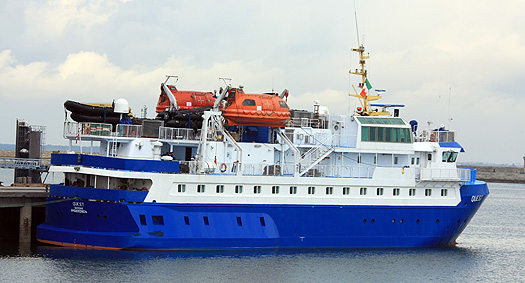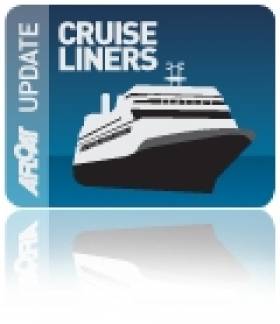Displaying items by tag: Carlisle Pier Dun Laoghaire
Cruise Callers to Dun Laoghaire ‘Recalled’
#DUN LAOGHAIRE CRUISELINERS – The recent call of what is believed to be the world's smallest cruiseship the Quest (1991/1,180grt) to Dun Laoghaire Harbour as part of an initiative to develop this sector is by no means completely new to the harbour, writes Jehan Ashmore.
It was not until a decade ago that the last cruise callers were on the scene, albeit making infrequent visits and they also varied considerably in size. Among the callers was the famous 'Cunarder' Queen Elizabeth 2 or 'QE2', RCCL's Norway formerly French Line's France and Celebrity Cruise then brand new Constellation. Notably these large vessels all made anchorage calls in Dublin Bay.
Constellation made this call in 2002 as did the Sun Bay II which was also then recently launched into service and the cruiseships were making their debut season in European waters. They could not be so different, the 2,800 tonnes Sun Bay II with an 89 passenger capacity in complete contrast to the 90,000 tonnes Constellation with over 1,800 passengers.
The diminutive Sun Bay II was not too dissimilar to Noble Caledonia's Quest in terms of passenger capacity being slightly smaller with a capacity of 52. She was alongside Carlisle Pier where her guests were on a 9-night Garden themed cruise of UK and Ireland that included tours to Powerscourt and Mount Usher in Co. Wicklow.
On the call of Constellation she anchored relatively closer to the shore off Bulloch Harbour, compared to QE2 and Norway's calls and she presented an imposing and impressive sight.
In the case of the Norway, her passengers were ferried to the marina by unusually large tenders more akin to tank landing craft as they bow doors (click PHOTO). In fact they were so large that they could not be stowed on the lifeboat deck and instead located forward of the bridge where deck-mounted cranes were used for hoisting operations.
The practice of anchorage calls will continue as vessels of this size will remain too large to be accommodated in the harbour in the short term, though the Dun Laoghaire Harbour Company's 'masterplan' includes a proposed €18m new cruise terminal. They claim the terminal would be capable of handling the largest and most modern cruiseships in the world.
In the meantime the landing point for tenders to use a new tender dock facility was installed recently at the Traders Wharf, as distinct to the Carlisle Pier (site of proposed Diaspora Museum) where small to medium sized vessels are to berth.
A further three more calls are scheduled this season, including a return call next week of Quest and other vessels capable of carrying around 500 passengers. This figure is to rise considerably in May 2013, thanks mostly due in part to the massive Cunard Line flagship Queen Mary 2 (QM2). The 151,400 tonnes 'liner' can take over 2,600 passengers and 1,200 crew alone.
With the visit of QM2, this is to be her fist call to Dublin Bay, as she is still to be big even for Dublin Port to handle. Likewise the rivals across Dublin Bay in the Dublin Port Company are proposing as part of their masterplan to build a €30m dedicated cruise terminal. This facility would also be able to accommodate very large cruise callers.
It will be interesting to see how both completing ports progress and how they market themselves to the cruise sector industry, no doubt across the board. The giant ships look after large volumes which keep cruise prices down. As for the smaller boutique style of cruiseship operators, they can command higher prices by targeting the top end of the market and where they have higher-spending power at ports of call . The cruise industry overall is becoming increasingly more globalised where it was traditionally the preserve of the European and North American markets.
Arguably it is debatable if there should be two cruise terminals built as it reminiscent of the controversary during the '80's over the battle between which Dublin Bay port would be chosen for the site of a new single dedicated multi-user car-ferry terminal.
As it transpired the ferry service to Holyhead remains operating out of Dun Laoghaire Harbour, where a new terminal was built specifically to dock the revolutionary design of the HSS (High-speed Sea Service) fast craft catamaran car-ferry. Albeit in recent years the route's sailing frequency has reduced considerably. Under the last contract between Stena and the harbour company, this has led to considerably less revenue generated in harbour dues. The HSS Stena Explorer currently maintains only a single daily round-trip and only on a seasonal basis between April-September.
While at Dublin Port a multi-user ferry terminal was built but Stena Line did not immediately become part of the facility. It was not until 1995 that they set up an additional new service from Dublin Port to Holyhead. They use a second adjacent terminal that is currently served by two ferries on the company's second route to Wales.
Cruise Call Opens New Opportunities for Dun Laoghaire Harbour
#CRUISE CALLS - The docking of the Quest in Dun Laoghaire Harbour this morning marks the first phase of cruise calls this summer as part of a new development to attract cruiseships, writes Jehan Ashmore.
The opening of the cruise sector business which formed part of the Dun Laoghaire Harbour Company's Masterplan is seen as a significant boost to the local economy considering the declining operations of the HSS fast-ferry service in recent years.
The Quest which is operated by Noble Caledonia is on a 9-night 'Garden' Cruise of the UK and Ireland, where prices started from £3,295. She berthed at the Carlisle Pier where for many generations passengers boarded the mail-boats followed by the conventional ferry to Holyhead which last left the route in 1996.

Quest along side in Dun Laoghaire. She carries 50 passengers
At just under 50m long the Quest carries only 50 passengers though this number is set to increase when a further four cruise calls are scheduled this season with larger vessels capable of carrying around 500 passengers.
Dun Laoghaire-Holyhead (HSS) High Speed Sailings Close
The core reason to withdraw the HSS on the 120-minute route which is not to re-open until the 2012 season, rests with the high operating costs of the fuel-thirsty fast-ferry which is powered by four gas-turbine engines. In addition the route's generated most of its turnover during the period May-September, leaving the remaining months unsustainable, as such the company wants the route to be seasonal-only in the long-term.

HSS Stena Explorer departs Dun Laoghaire Harbour on her final sailing this season. Photo: Jehan Ashmore
Passengers and freight customers will instead need to use the company's other Dublin Bay route between Dublin Port and Holyhead. The 3 hour 15-minute central corridor route is served by two ro-pax vessels, Stena Adventurer (2004/43,532 grt) and Stena Nordica (2000/24,206 grt) which operate to a year-round schedule, for times click HERE.
What is not certain is the precise date for resumption of Dun Laoghaire-Holyhead services as Stena Line have only indicated that they hope to reopen in April or May nor it is outlined as to what type of fast-craft would operate the route next year.
With today's break in service for at least the next six months, this is the most significant absence of the revolutionary HSS (High Speed Sea Service) 1500 fast-ferry which made her official maiden voyage on the route from Dun Laoghaire on 10th April 1996. The only other notable occasions when the HSS was off-service was for the short spells to allow for annual dry-docking, refit, repairs or when the route in recent years was partially operated by Stena Lynx III.
The 1500 referred to the number of passengers the Stena Explorer could accommodate. She was the first of the three Finish-built HSS 1500 catamaran vehicle capable carrying craft to enter service on three routes from the UK. The next sister completed HSS Stena Discovery entered service in the same year between Harwich-Hook van Holland and the final of the trio HSS Stena Voyager entered the Belfast-Stranraer route in 1997. Several years ago the HSS ceased operating on the Dutch route and the HSS currently serving on the North Channel is due to be replaced by conventional ferries in mid-November as previously reported on Afloat.ie, to read more click HERE.
On the Dun Laoghaire-Holyhead service the HSS enjoyed the boom years, and at its peak there were five daily round trips. From 2006 onwards the routes fortunes began to decline due to the ending of duty-free sales, competition from low-cost airlines, and the increasing cost of fuel.
In order to stave off further losses, a series of cost cutting measures were implemented over the next five years. Firstly the sailing frequency was reduced then the passage times were increased to reduce fuel consumption at the expense of faster crossings. In addition the company resorted to withdrawing the Stena Explorer during the shoulder months surrounding the summer and as previously mentioned these sailings were covered by the Stena Lynx III.
When the Stena Explorer returned for the summer months, the Stena Lynx III switched to her normal high-season spell on Rosslare-Fishguard sailings in tandem with regular route vessel Stena Europe. This year she served as usual on the St. Georges Channel route with the last high-season sailing completed on 4 September.
Stena Lynx III remained initially at Fishguard until making a repositioning voyage to Dun Laoghaire via the Kish Lighthouse last Wednesday. She berthed adjacent to the now disused HSS berth link-span on St. Michaels Wharf. The Tasmanian built craft has spent previous winter layover periods in Dublin and last year in Dun Laoghaire whereas the Stena Explorer is expected to do so in her home port of Holyhead.
At the neighbouring Carlisle Pier, the former terminal where numerous steam-packets, 'mailboats' and the conventional Sealink/British Rail car-ferries served (the last being the Stena Adventurer better known as St. Columba built in 1977) there are plans for a national diaspora museum.
The centrepiece landmark building would form as part of the masterplan proposed by the Dun Laoghaire Harbour Company as part of a concerted effort to offset the reduced role of ferry operations. The masterplan is also to attract cruiseship business amongst other proposals envisaged.
- Dublin Port
- Dun Laoghaire Harbour Company
- Cruise Liners
- HSS Stena Explorer
- Dun LaoghaireHolyhead
- Stena Lynx III
- Stena Line
- Port of Dublin
- Ports and Shipping News
- Ferry news
- Stena Explorer
- HSS
- St.Michaels Wharf
- Dun Laoghaire Harbour News
- Stena Adventurer
- Irish Sea ferry news
- Cruise ships
- Carlisle Pier Dun Laoghaire
- Stena Nordica
- Closure of HSS sailings
- HSS (High Speed Sea Service)
- Dun Laoghaire masterplan
- Diaspora Museum Dun Laoghaire
‘Family Fun Day’ in Dun Laoghaire
Funds raised will go to the maritime museum which is housed in the former Mariners Church, which is run by the Maritime Institute of Ireland (M.I.I.). The museum is currently closed due to continued renovation and improvement works.
There will be a 'soft launch' or 'preview' of the maritime museum from October to mark the M.I.I.'s 70th anniversary. Next year the museum is due to be officially re-opened during the Easter. The M.I.I. welcomes new members, volunteers and donations to assist in the museum. For information visit www.mariner.ie
































































